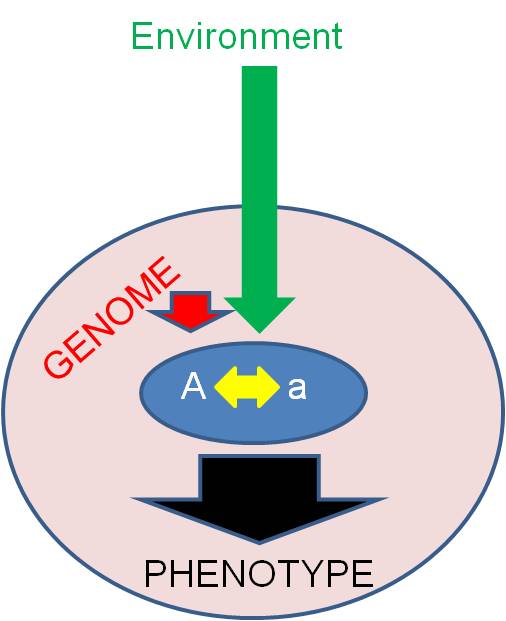 A.
Overview
A.
Overview
While Mendel's contributions were seminal, his postulates and principles did not describe the full range of complexity that occurs in the patterns of heredity or the expression of genetic information in the phenotype. Although many genes exhibit simple patterns of complete dominance, even segregation, and independent assortment, many do not. In addition, the genes that are received by an organism are not the sole determinant of the phenotype - even of the characteristics that these genes affect. For the remainder of this unit, we will look at how Mendelian patterns are modified (or even violated).
 A.
Overview
A.
OverviewIn addition to considering whether (and how) an alelle is expressed, we will also consider the "value" of the allele to the organism (is it 'good' or 'bad'?) This may not be an intrinsic property of the allele. Rather, the value of an allele is also determined by these three classes of factors. Keep this in mind; it is the overriding message of transmission genetics. Unfortunately, our culture has not always appreciated these ideas.
Diploid organisms have two alleles for each locus, or gene. Intralocular effects describe the way that these alleles interact to cause a phenotype. You are familiar with one type of intralocular interaction already, so we will start there.
1. Complete Dominance (Mendelian)
In this case, the heterozygote expresses a phenotype indistinguishable from the phenotype of the homozygous 'dominant' individual.
- AA = Aa > aa (Mendel's peas provide examples)
At a cellular level, why does this happen? Well, genes code for proteins. Apparently, one gene (A - the dominant gene) codes for the production of enough functional protein for complete cell function and phenotypic expression. Surplus has no effect. Maybe a reaction is limited by the amount of substrate, and not the concentration of enzyme (protein). So, one 'dose' of enzymes is enough to metabolize all of the substrate, and extra enzyme doesn't change this effect. Or the product of the dominant allele has a higher reactivity with the substrate and always reacts with it, it's way, even in the heterozygous condition.
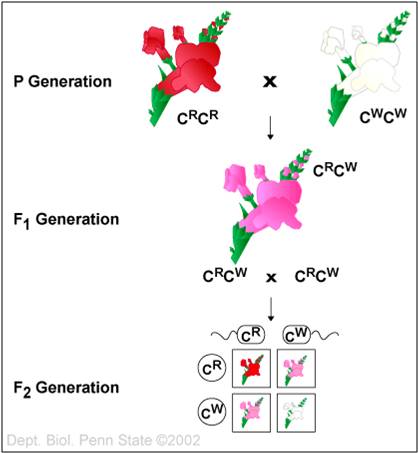 2.
Incomplete Dominance/Intermediate Inheritance
2.
Incomplete Dominance/Intermediate Inheritance
In this case, the heterozygote expresses a phenotype that is intermediate between the phenotypes expressed by the homozygotes. This is quite common. A classic example is flower color in 4 o'clocks. Homozygotes for R ("RR") produce red flowers, homozygotes for "r" (rr) produce white flowers, and heterozygotes (Rr) produce pink flowers.
- AA > Aa > aa
At a cellular level, this is probably a function of a 'dosage effect'. Two 'on' genes produce more functional product than one, and this surplus influences cell function and phenotypic expression. Maybe the protein product of an active R gene is the pigment, itself, and r produces a nonfunctional protein (maybe it has a premature stop codon and no protein is even produced). So, the two functional genes in the RR homozygote produce more pigment and a deeper red color than the single functional gene in the pink heterozygote (Aa).
3. Codominance
In this case, the heterozygote expresses both traits completely; this does not produce something that is "in between" the homozygotes; rather, the heterozygote expresses both traits expressed in the homozygotes. The classic example is the A-B-O blood group in humans. These letters refer to alleles in the human population that encode a protein that is placed on the surface of blood cells. These proteins are called 'surface antigens', and they act as a chemical signal to white blood cells that these cells are "self". There are three alleles in the human population at this locus. Of course, each diploid person only has two of these three alleles. The genotypes that are possible, and the phenotypes they express, are as shown:
| Genotype | Interaction between alleles | Phenotype |
| AA | A | |
| AO | A dominant to O | A |
| BB | B | |
| BO | B dominant to O | B |
| OO | O | |
| AB | A and B codominant | AB |
The A allele codes for the A surface antigen. The B allele codes for the B surface antigen. The O allele is non-functional; no surface antigens are produced. So, any genotype with an A allele makes A surface antigen; any genotype with a B makes B surface antigen. A genotype that is AB has different active genes, each producing their own surface antigen, and so BOTH A and B surface antigens are affixed to the outside of the cell. It is a phenotype that is BOTH A and B at the same time.
A more general cellular explanation is this. The allelic products are both functional and work on slightly different substrates. Having both gives the phenotype a qualitative diffence, not a quantitative difference. This is often confused with "incomplete dominance", but think about it this way: "pink" flowers are neither "red" nor "white" - they are something different that isn't red or white. But AB blood is BOTH A and B at the same time, not different from A and B, but a combination of both A and B.
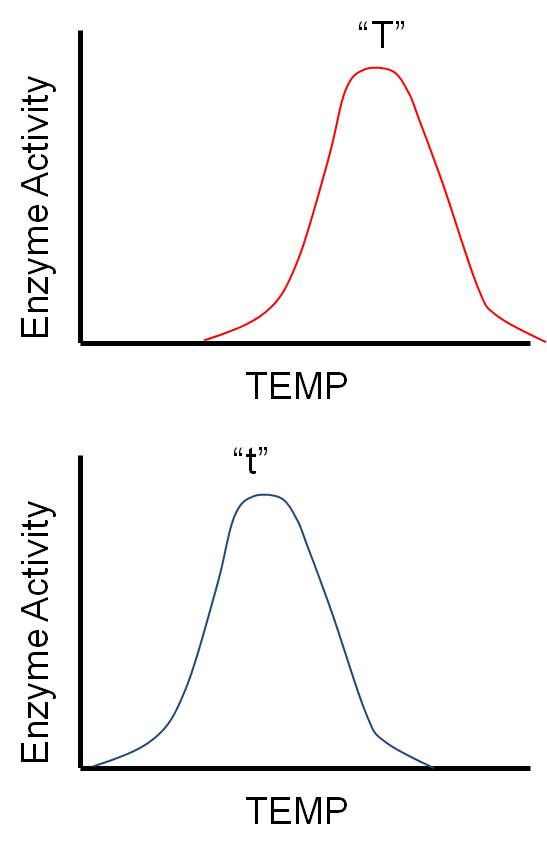 4.
Overdominance (Heterosis)
4.
Overdominance (Heterosis)
In this seemingly unusual situation, the heterozygote expresses a phenotype "more extreme" than either homozygote. So, if AA = tall and aa = short, then the heterozygote Aa = Tallest.
This may seem unusual, but it is actually easy to explain. Suppose the two alleles work slightly differently, or under slightly different conditions. For instance, consider a gene that codes for an enzyme that influences growth. As you can imagine, there are LOTS of such genes! Almost any catalyst that affects metabolism, respiration or protein synthesis will influence growth. Maybe the two alleles for this enzyme work at different temperatures (H = warm and h = cold). If the organism lives in an environment that is warm most of the time, then the homozygote for HH will grow most of the time, and will be taller than the hh homozygotes that only grow during the rare colder periods. However, the heterozygote Hh grows ALL the time, when it is cold and warm, and so is taller than either homozygote. Variation at a locus can be as advantageous as variation in offspring; variation in the genotype (heterozygosity) may allow the organism to cope with a greater range of environmental conditions, or metabolize more substrates. Thus, there is often a 'heterozygote advantage' at certain loci.
5. Multiple Alleles
This doesn't describe an interaction, but merely a pattern. As the A, B, O blood group locus demonstrates, many genes have more than just two alleles in a population. And, as the previous example of heterosis shows, variation within a locus can be evolutionarily important. So, this variation that occurs because there are multiple alleles at a locus creates even more types of heterozygotes that are possible, and more genotypes, too. For example, consider the multiplicative increase in genotype diversity that occurs when each additional allele is added in the table, below:
1 allele (A) = 1 diploid genotype (AA)
2 alleles (A, a) = 3 diploid genotypes (AA, Aa, aa)
3 alleles = 6 diploid genotypes (as in the A,B,O example, above...)
4 alleles = 10 diploid genotypes
5 alleles = 15 ....etc.
So, when a new gene is produced by mutation, it does not just make ONE new genotype. It has the potential, through independent assortment, to be combined with all the other alleles already present in the population. So, in the example above, when a new FOURTH allele is added, you don't just get one new genotype (over the 6 that existed in the three-allele population), you get 4 more genotypes. There is a multiplicative effect on variation. And, since alleles may interact in interesting ways (incomplete dominance, codominance, and overdominance), these new genotypes may produce new phenotypes never produced before - new variation upon which selection can act.
As a consequence of many loci acting on a trait, there are many more combinations that are possible - resulting in a wide variety of phenotypic expression that forms a nearly 'continuous' range of variation.
For example, consider human skin pigmentation. There are at least 16 loci that code for melanin (skin pigment) production. Although there is complete dominance at each locus, this multiplication of genes allows for an extraordinary and continuous amount of phenotypic variation, from all 16 genes 'on' (and very very dark skin), to 15 'on' and 1 'off' ( very dark skin), to 14 'on' and 2 'off' (a bit lighter), to , 13:3, etc. , all the way to 0 'on' and 16 'off' (no pigments produced at all).
Humans evolved on the plains of Africa. The loss of hair was adaptive (to decrease insulation in the subtropical heat), but this made the skin vulnerable to UV rays that cause mutation. Selection favored humans that could make lots of melanin, to protect the skin against these UV rays. Selection favored humans that duplicated their melanin genes, and could thus produce more pigment. Humans that continued to live in tropical areas continued to benefit from this dark skin. In cooler climes with less intense sun, selection favored humans that spent less energy on melanin production, selecting for the recessive alleles at each of these multiple loci. In addition, lighter skinned people benefitted at these latitudes by using the sun's energy to synthesize vitamin D in the skin.
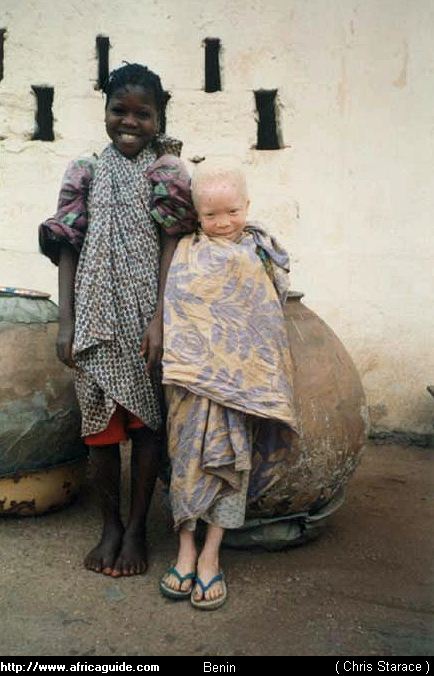 In
epistasis, one locus has precedence over the expression at another locus and
can override it. Albinism is the classic example. Albinism ooccurs in all populations
of humans (and many other animals). It usually does NOT involve the melanin
producing genes. (So, true albinism is NOT caused by the 0 'on', 16 'off' scenario
described above). Rather, it involves another locus. An 'aa' individual at the
albinism locus does not make the precursor for melanin. So, with no
precursor from which melanin can be made, it doesn't matter WHAT the genotypes
are at the 16 melanin loci - there won't be any melanin produced. This is why
albinism occurs in all human populations (or 'races') regardless of of the skin
color typical for that population - because it is influenced by a gene that
is inherited independent of the melanin producing genes.
In
epistasis, one locus has precedence over the expression at another locus and
can override it. Albinism is the classic example. Albinism ooccurs in all populations
of humans (and many other animals). It usually does NOT involve the melanin
producing genes. (So, true albinism is NOT caused by the 0 'on', 16 'off' scenario
described above). Rather, it involves another locus. An 'aa' individual at the
albinism locus does not make the precursor for melanin. So, with no
precursor from which melanin can be made, it doesn't matter WHAT the genotypes
are at the 16 melanin loci - there won't be any melanin produced. This is why
albinism occurs in all human populations (or 'races') regardless of of the skin
color typical for that population - because it is influenced by a gene that
is inherited independent of the melanin producing genes.
Multiple loci may influence genes in interactive ways, not just in quantitative, additive ways like skin color. For example, in sweet peas (not the garne peas of Mendel), there are two genes that influence flower color. Both exhibit complete dominance, and both proteins must be produced in order for purple flower color to be expressed. So:
aaBB (white) x AAbb (white)
|
100% AaBb (purple)
|
9/16 A_B_ (purple)
7/16 aaB_ or A_bb or aabb (white)
(In these examples, the underlined space means that it doesn't matter what the second allele is... if one allele at a locus is dominant, then in a completely dominant system, you will get the same phenotype regardless of whether the second allele is dominant or recessive. So, rather than writing all the separate genotypes out that yield the same phenotype, you just put the genes that determine the phenotype. Of course, to express the recessive phenotype, you have to be homozygous - so to represent genotypes that express the recessive phenotype, you need to write both alleles. aaB_ refers to aaBB and aaBb... they both yield the aB phenotype.)
In Summer Squash, fruit shape is influenced by interacting loci. Disc-shaped fruits form when both loci have at least one dominant allele present (A_B_). Long fruits are produced when dominant alleles are absent (aabb), and round fruits are produced when one locus is homozygous recessive but the other has at least one dominant allele. SO:
AABB (disk) x aabb (long)
|
100% AaBb (disk)
|
9/16 A_B_ (disk)
6/16 A_bb or aaB_ (ROUND)
1/16 aabb (long)
These effects are VERY important, because every organism has thousands of genes. So, at a given locus, it is quite likely that the way the genotype is expressed might be influenced by one of these other genes somehow. This means that two organisms with the SAME genotype at a given locus would have different phenotypes... because of the effects of the other genes in the genotype. Sometimes, these effects are collectively called the "genetic background". Like for squashes, above, consider two organisms that are both AA at the A locus. They could have different penotypes because of their genetic differences at other loci; the first could be AABb and have disk fruits, while the other is AAbb and have round fruits.
3. Position Effects - neighboring regions may influence the expression of a gene; a gene may be 'on' if it is next to an enhancer/promoter, 'off' if it is bound to the histones (the'beads' on the string of a chromosome...) So, two people could have the SAME genotype, but if these genes may be in different position on a chromosome (for mutational reasons we will explain) and have different phenotypes.
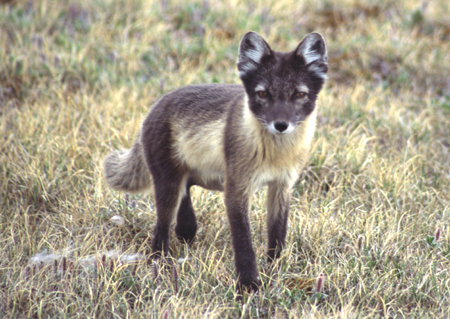 C.
Environmental Interactions
C.
Environmental InteractionsThe environment has many direct effects on the phenotype. A fox may change from white to brown because a bucket of white paint falls on it's head. That would be a direct environmental effect; it happened independently of anything going on with the genotype. Those are NOT the effects we are talking about here. Rather, we are talking here about an interactive effect between the environment and the genes at a locus, such that the environment changes how the genotype is expressed as the phenotype.
1. Temperature
In arctic fox, the brown summer fur turns to white as temperatures drop. This is NOT a direct effect of temperature change on pigment in the hair shaft. Rather, the change in temperature changes how the genes and their protein products work. As temperatures drop, melanin genes are turned off, or the enzymes that catalyze the production of melanin change shape and no longer function. The result is that no melanin is produced, and thus the fur turns white.
2. Toxins
Susceptibility to certain mutagens will vary with the genotype. So, two people who are homozygous for a type of lung cancer (and 'should' genetically express that cancer) might have very different phenotypes. One, who smokes and exposes their lungs to mutagenic compounds might trigger those cancer genes. The other person, however, with the same genotype, might not have cancer because they never smoked and thus never exposed themselves to the environmental "trigger". Likewise, someone homozygous for an alternative allele might smoke without developing lung cancer.
These effects may be "probabilistic". For instance, some genes associated with cancers are only expressed (cause cancer) in a fraction of the individuals with that genotype. This could be due to different environmental exposure, but it could also be caused by different genes at other loci that interact with this cancer gene and augment or supress its effects through interlocular interactions.
D. The 'Value' of an Allele
1. Lethal Alleles: Some alleles are ALWAYS bad.
Usually, these have rather profound effects on basic cellular metabolism, affecting a vital enzyme or structural protein. Typically, lethal alleles that are DOMINANT get weeded out of the population very quickly by selection (anyone that gets one allele dies...). So, most lethal alleles that are maintained in natural populations are recessive, and thus are "hidden" in heterozygotes and are be passed down through generations. However, some lethal alleles ARE dominant. Can you think of another way that an allele could 'escape detection' by selection (which is "differential REPRODUCTIVE success"?). Huntington's Chorea is a dominant lethal neurodegenerative condition. Actually the Homozygote dies in utero. However the heterozygotes survive and are phenotypically normal into their 50's. THEN, only AFTER they might have reproduced and passed the gene on, do the effects of this dominant gene start to come forward. So, they are "invisible" to selection because they are expressed POST-REPRODUCTIVELY.
2. Environmental Effects: The value of an allele often depends on the environment
In Sickle Cell Anemia, red blood cells 'sickle' when the concentration of oxygen in the bloodstream drops. This occurs when the person is active and the oxygen demand by muscle increases, drawing oxygen out of the bloodstream and depressing oxygen concentration in the cells in the bloodstream. The sickle-shaped cells do not pass through capillary beds as easily as normal red blood cells; they clog capillaries, resulting in oxygen deprivation and tissue damage downstream from the clot. This is usually most pronounced in the liver, kidneys, and brain, and eventually often results in premature death.
Sickle cell anemia is caused by an altered beta globin allele, which causes a single amino acid change in the beta-globin proteins in hemoglobin. The trait exhibits incomplete dominance - one "s" allele will result in some "sickling" of red blood cells at low oxygen concentration, but the condition is not nearly as severe as it is in the homozygous condition.
Now, you might think that even one sickle-cell allele would 'always be bad' - after all, I just said that heterozygotes do suffer some debilitating effects. But in this case, the "value" of a sickle cell allele - whether it is 'good' or 'bad' - depends on the environment. In particular, it depends on the presence of the Plasmodium parasite that causes malaria.
In the tropics, a primary source of human mortality is malaria. In 2006, nearly 900,000 people died of malaria; over 91% of these deaths were children in Africa. There were an estimated 250 million cases reported globally. Malaria is caused by several species of protists in the genus Plasmodium. This single-celled parasite is transmitted by female mosquitos. When they bite a human to take a blood meal (only female mosquitos drink blood - they use the protein to nourish their developing eggs), the parasites enter the human host's bloodstream and infects red blood cells. They divide mitotically, producing hundreds of offspring and eventually rupturing the cell. Thus, infection causes extreme loss of RBC's - "anemia" (don't get this confused with sickle cell anemia; we are just talking about malaria right now!!). Curiously, the Plasmodium parasite can not reproduce in cells with the altered form of "sickle-cell" hemoglobin - even in the heterozygous condition. So, the heterozygote suffers some sickling on occasion, but is protected from malaria. In Africa, SS homozygotes have lower survivorship than the Ssheterozygotes because the SS individuals are exposed to malaria. The ss homozygotes have lower survivorship than the Ss heterozygotes because of the more pronounced debilitating effects of the sickle cell disease.
So, is an 's' allele "good" or "bad"? Well, that depends on other alleles at that locus (if it's with another 's' allele it is always bad), but it also depends on the environment. If the 's' is with an 'S' in the temperate zone, it is bad (relative to the reproductive succes of the normal SS homozygote).... but if the 's' allele is paired with an 'S' allele in the tropics, then it is "good" - better than having two dominant alleles (SS).
TEMPERATE ZONE: survivorship: SS > Ss > ss
TROPICS: survivorship: SS < Ss > ss
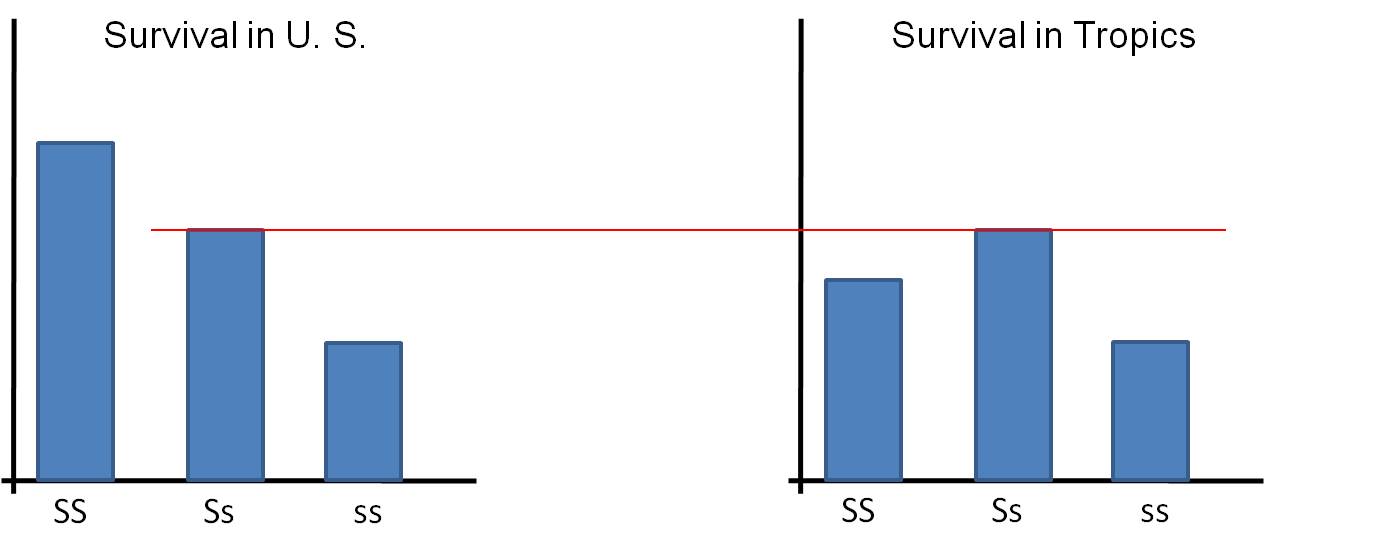
You should relate this to the corollary of Darwin's Theory of Natural Selection.
Populations in different environments will diverge from one another genetically,
as the environment selects for different traits (genotypes).
E. Summary:
An organism is more than just the sum of their parts, even at a genetic level. How the genotype works is not just the additive sum of all the genes acting independently. Rather, the way some genes work depends on the other genes in the genotype. The phenotype - what a complex organism IS - is the result of these complex interactions between genes, with the additional layer of environmental interactions and direct environmental effects. Indeed, given the potential complexities involved in how 1000's of genes and a complex environment can interact, it is rather surprizing that many genetic effects are simple enough to model as independent entities with a Punnet Square - without considering the other genes or the environment. So, Mendelian Genetics are actually the easiest, simplest patterns in heredity to recognize: and that is probably why they were recognized first.
Study Questions.
1) Explain how a continuously variable trait could be governed by genes.
2) What is an epistatic interaction? Give an example.
3) Describe how the position of a gene can affect its effect.
4) How can the environment influence the expression of a trait?
5) How can the environment influence the VALUE of a trait? Relate this to Darwin's idea of the diverge of populations in different environments.
6) Why are most lethal alleles recessive? Answer with respect to the effects of selection on a dominant, deleterious gene.
7) As such, how can a dominant lethal allele be maintained in a population?
8) Consider this cross:
AaBbCc x AaBbCC
- assume independent assortment of the three genes
- There is incomplete dominance at the A locus (meaning A is incompletely
dominant to a).
- There is complete dominance at the B locus.
- There is overdominance at the C locus.
How many genotypes are possible in the offspring?
How many phenotypes are possible in the offspring?
9. Conduct the following cross: Aa x Aa
Determine the genotypic and phenotypic ratios if there is:
- complete dominance
- Incomplete dominance
- Codominance
- Overdominance
10. Provide a cellular explanation for overdominance.